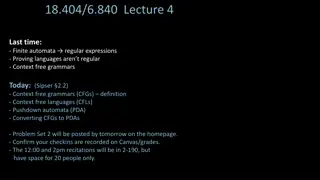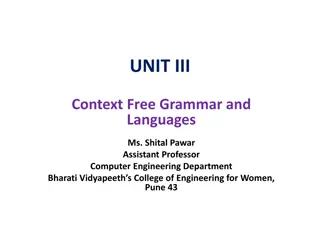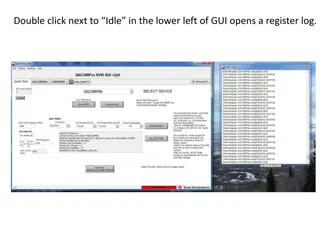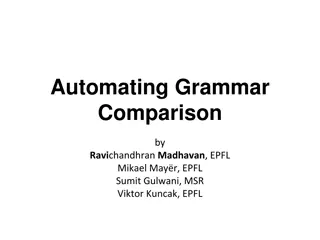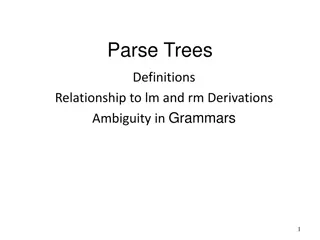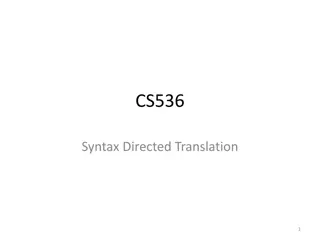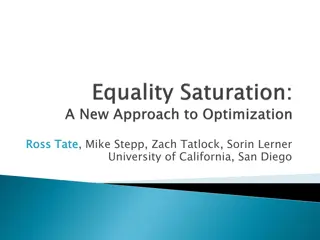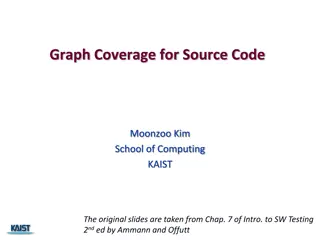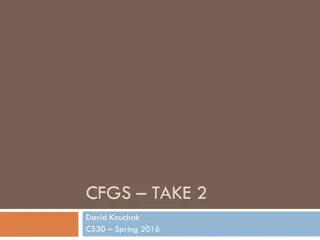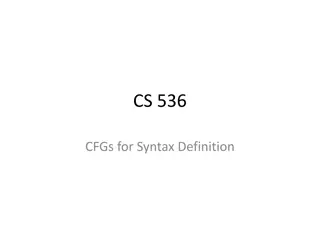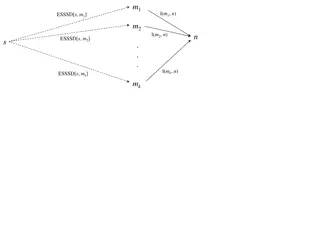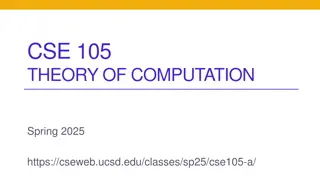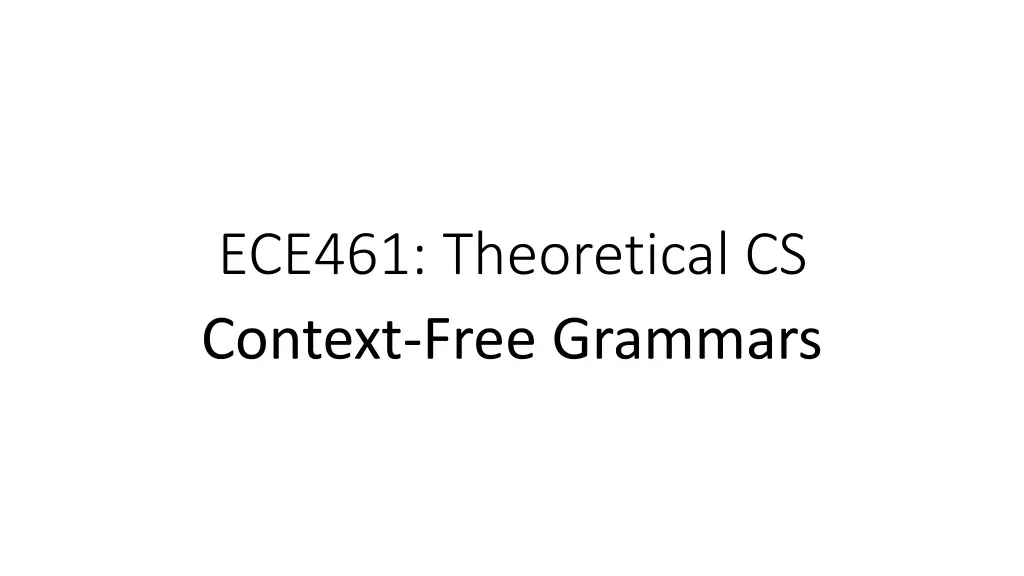
Exploring Context-Free Grammars in Computational Theory
Discover the power of context-free grammars (CFGs) in computational theory, their historical significance, and how they extend beyond regular languages. Gain insights into CFGs' applications in specifying programming language syntax and natural language grammar rules, as well as their limitations in describing certain languages.
Uploaded on | 1 Views
Download Presentation

Please find below an Image/Link to download the presentation.
The content on the website is provided AS IS for your information and personal use only. It may not be sold, licensed, or shared on other websites without obtaining consent from the author. If you encounter any issues during the download, it is possible that the publisher has removed the file from their server.
You are allowed to download the files provided on this website for personal or commercial use, subject to the condition that they are used lawfully. All files are the property of their respective owners.
The content on the website is provided AS IS for your information and personal use only. It may not be sold, licensed, or shared on other websites without obtaining consent from the author.
E N D
Presentation Transcript
ECE461: Theoretical CS Context-Free Grammars
Brief Recap In previous topics, we have learned about three formalisms capable of recognizing regular languages: Deterministic finite automata (DFAs) Nondeterministic finite automata (NFAs) Regular expressions (REs) Regular languages could potentially be defined in terms of any one of these formalisms Remember that, more generally, a language is a set of strings (possibly infinite), and a string a finite sequence of symbols from an alphabet These three formalisms are equal in power; i.e., they are capable of representing exactly the same class of languages (the regular languages) We have also learned that each of these formalisms is limited; that is, there are nonregular languages that cannot be represented by them We discussed the pumping lemma for regular languages, which can be used to prove that certain languages are nonregular
Context-Free Grammars In this topic, based on Section 2.1 of the textbook, we will learn about a more powerful formalism than the three previous discussed This formalism is called a context-free grammar (CFG) CFGs can describe all regular languages, and they can also describe certain nonregular languages CFGs are often used to specify the syntax rules of programming languages, and to implement compilers CFGs have historically been used by linguists to attempt to specify the grammar rules of natural languages, and in computational linguistics (a sub-field of NLP), they have been used to implement parsers In our next topic, we will learn about another formalism, called a pushdown automaton, that is equally powerful to CFGs The class of languages that can be described by CFGs or pushdown automata are known as context-free languages (CFLs) Although more powerful than the formalisms we previously learned about, CFGs and pushdown automata still cannot describe all languages; that is, some languages are not context free Two topics from now, will learn about another form of the pumping lemma that can be used to prove that certain languages are not context free
Brief History of Context-Free Grammars As our textbook states, "context-free grammars were first used in the study of human languages" (although the book provides no details about the history) Chomsky was hugely influential in the study of context-free grammars and related formalisms In a 1956 paper, Chomsky first described phrase-structure grammars, and he discussed (in an earlier form) what is now known as the Chomsky hierarchy, which includes, from most powerful to least powerful: Recursively enumerable languages (which can be recognized by Turing machines) Context-sensitive languages (we won't be learning about these, but they can be recognized by nondeterministic linear bounded Turing machines) Context-free languages (we will learn about these over the next few topics) Regular languages (we already learned about these) Chomsky continued to formalize and describe properties of CFGs and CFLs over the next few years Chomsky may also be the person who first formalized the pushdown automaton, although that is less clear Chomsky's theories dominated linguistics for decades, although some have always been controversial The pumping lemmas for both context-free languages and regular languages were proven in a 1961 paper by Bar-Hillel, Perles, and Shamir Some sources refer to the pumping lemma for context-free languages as the Bar-Hillel lemma Some sources claim that the pumping lemma for regular languages was previously proven by Rabin and Scott, although others cite the Bar-Hillel, Perles, and Shamir paper as the source of the original proof
CFG Terminology The textbook shows a simple example of a CFG; we will call this G1: A 0A1 A B B # Each line is a substitution rule, a.k.a. a production; these are often referred to simply as rules The book says that each rule consists of "a symbol and a string separated by an arrow" The book refers to the symbols to the left of the arrows as variables; I have typically seen these referred to as nonterminal symbols (or nonterminals), and I will often call them that The strings on the RHS of the arrows consist of nonterminal symbols and terminal symbols (or terminals) One variable is designated as a start variable (I have often seen this called the start symbol); it conventionally appears to the left of the first arrow in a CFG There are a few things I want to point out: I don t generally think of the RHS of each rule as a "string", although it is a sequence of symbols; but the symbols in a string come from an alphabet, and here, the RHS of each rule consists of symbols from two sets (nonterminals and terminals) The textbook doesn't mention how to read such a rule; I have learned to read the arrow as "can have the form of" or "can consist of" I think the book should also make it clearer that there must be exactly one nonterminal symbol to the left of the arrow
Formal Definition of a CFG A context-free grammar is a 4-type (V, , R, S), where: 1. V is a finite set called the variables, 2. is a finite set, disjoint from V, called the terminals 3. R is a finite set of rules, with each rule being a variable and a string of variables and terminals, and 4. S V is the start variable. A few things to point out: I kept the textbook's wording of this exactly as they state it (except for adding a colon), but I feel like this is less precise than most of their definitions As with DFAs, NFAs, and REs, we can think of as the alphabet of the CFG, although the textbook does not seem to use the term alphabet when discussing CFGs The definition states what a rule consists of, but nothing about its form or meaning Contrasting this to their definitions of automata, it is clear, in those cases, that the transition function is a function, and therefore that it provides a mapping
Derivations Consider a rule A w, where A is a single variable and w is a string of variables and terminals (the required form for a production in a CFG) Also let u and v be other strings of variables and terminals We can write: uAv uwv Referring to the above substitution, we can saw that uAv yields uwv (referring to a single substitution) We can say that u derives v, written u *v, if u=v or if there is a sequence u1, u2, , ukwith k 0 such that u u1 u2 uk v Note that for the derivation symbol, the book places the asterisk centered above the arrow ( ); I could not figure out how to do that without pasting an image! For a CFG, G, with start symbol S, we can say that the language of the grammar is L(G) = {w *| S *w}
Context-Free Languages With DFAs and NFAs, it is common to say that each recognizes, or accepts, a language I also often state this about REs (as do some other sources), but it seems to be more common to say that a regular expression describes a language We can also say that a DFA, NFA, or RE accepts a string (a member of the language that it recognizes) With CFGs, it is common to say that each generates a language (the language of the CFG, as defined on the previous slide) A language generated by some CFG is called a context-free language (CFL) It is also common to say that a CFG generates a string that is a member of its language A few things I want to point out: Due to my background in NLP, I don't personally like this distinction between recognizing or accepting a language or string as opposed to generating a language or string This is because CFGs are often used as the basis for writing parsers, that can decide whether a sentence is grammatically correct according to a grammar Similarly, designers of programming languages use CFGs to specify the syntax rules of the languages, and implementations of compilers rely on CFGs when parsing programs However, I will try to generally follow the convention of referring to CFGs as generating strings and languages
Parse Trees I am re-pasting the simple CFG called G1: A 0A1 A B B # A parse tree is a graphical way of showing how a string can be generated by a CFG The figure to the right shows how the string 000#111 can be generated by G1 The book displays all terminals at the bottom to make it easier to read the string However, note that the symbols of the string occur at different depths of the parse tree This parse tree relates to the following derivation of the string: A 0A1 00A11 000A111 000B111 000#111
CFG: Interesting Example Consider the CFG: G3= ({S}, {a, b}, R, S) with R containing only one rule: S aSb | SS | Note that the | symbol is not officially part of the definition of CFGs This is used as a shorthand when there are multiple rules with the same LHS You can think of it as meaning "or" Also note that the empty string symbol, , can appear as the RHS of a rule in a CFG, but it is not considered one of the terminal symbols of the grammar G3can generate strings including: abab, aaabbb, aababb It cannot generate strings such as: aabbba, baba, aaabb I find it interesting that we can intuitively understand this language by considering another language we are already familiar with Instead of the alphabet {a, b}, consider the alphabet {(, )} Then, this language would consist of all properly nested parentheses
CFG: Arithmetic Example Consider the CFG: G4= (V, , R, <EXPR>), where: V = {<EXPR>, <TERM>, <FACTOR>} = {a, +, x, (, )} R includes the following rules: <EXPR> <EXPR> + <TERM> | <TERM> <TERM> <TERM> x <FACTOR> | <FACTOR> <FACTOR> ( <EXPR> ) | a <EXPR> is the start symbol This allows the generation (or parsing) of strings of a's, added and multiplied together, grouped using the standard precedence rules The figure on the next slide shows the parse trees for a+axa and (a+a)xa
CFG: Natural Language Example The book defines a CFG, G2, that they claim "describes a fraction of the English Language" This is seen at the right, on top Examples of sentences that G2can generate are seen at the right, at the bottom Some things I want to point out: I consider this example somewhat sloppy, which is unusual for the textbook They claim that the alphabet consists of lowercase letters and spaces (they call it "the blank symbol") They further claim that a space is "placed invisibly after each word" However, there is nothing in the grammar that does this! Also, in linguistics and NLP, it is common to consider terminals to be words as opposed to characters
CFG: Example with Union Consider the language: L = {0n1n| n 0} {1n0n| n 0} Note that the language to the left of the union was one that we proved to be nonregular in our previous topic The previous CFGs that we just covered are also nonregular (although we won't prove that) In any case, we can easily represent this with a CFG as follows: S1 0S11 | Similarly, we can represent the language to the right of the union as follows: S2 1S20 | Adding one more rule, we can create a CFG to generate L as follows: S S1| S2 S1 0S11 | S2 1S20 |
Regular Languages (re-re-revisited) We have just seen that some nonregular languages can be represented by CFGs Additionally, all regular languages can be represented by CFGs; the textbook explains this as follows: If a language is regular, there is a DFA, M, that recognizes it For every state, qi, of M, make a variable (nonterminal) called Riin the CFG For the variable, R0, that corresponds to the start sate, q0, of M, make R0the start variable of the CFG For every transition (qi, a) = qjin M, add the rule Ri aRjto the CFG If qiis an accept state of M, add Ri to the CFG The book does not step through the proof more formally, but this constructed CFG is guaranteed to generate the same strings that M recognizes The textbook's explanation is in a subsection called "Designing Context-Free Grammars" giving advice that might help when constructing a CFG for language Of course, this means that the regular languages form a subset of the context-free languages I feel like the book should give this proof more emphasis; it is an important fact In our next topic, we will see another proof that all regular languages are context free
Ambiguity For some CFGs, there are multiple ways to derive the same strings, leading to different parse trees Such a CFG is said to be an ambiguous grammar As an example of an ambiguous CFG, consider this alternative grammar for generating arithmetic expressions, which we will call G5: <EXPR> <EXPR> + <EXPR> | <EXPR> * <EXPR> | ( <EXPR > ) | a This CFG generates exactly the same language as one of the previous grammars that we saw, G4 Although we will not prove it, G4is not ambiguous; that is, every valid string has exactly one parse tree However, with G5, some strings have ambiguous derivations, leading to different parse trees The next slide shows two parse trees for the string a+axa using this ambiguous grammar, G5 Note that evaluating the expression using the two parse trees leads to two different results One of the two parse trees follows the standard precedence rules, but the other does not In NLP and linguistics, ambiguous parse trees represent different ways to syntactically parse valid sentences, in turn leading to different semantic interpretations of sentences
Formal Definition of an Ambiguous CFG Note that many parse trees can lead to different derivations, because we can place nonterminals in any order that we choose This does not mean that a grammar is ambiguous To avoid this confusion, we can replace nonterminals in a fixed order, from left to right A leftmost derivation is one in which the leftmost remaining variable is the one replaced at every step With this understanding, we can define ambiguity as follows (Definition 2.7 from the textbook): A string w is derived ambiguously in context-free grammar G if it has two or more different leftmost derivations. Grammar G is ambiguous if it generates some string ambiguously. If there are two or more leftmost derivations of a string, those will lead to different parse trees Although we will not prove it, some context-free languages are inherently ambiguous, meaning that any CFG generating such languages will be ambiguous
Chomsky Normal Form Definition 2.8 defines Chomsky normal form as follows (I am using the book's wording exactly here): A context-free grammar is in Chomsky normal form if every rule is of the form A BC A a Where a is any terminal and A, B, and C are any variables except that B and C may not be the start variable. In addition, we permit the rule S , where S is the start variable. Coming from an NLP background, I am used to seeing Chomsky normal form without the extra clauses at the end Disallowing the start symbol on the RHS is helpful for certain proofs, and it does not decrease the power of the formalism if the rule S is allowed The rule S is only needed in contexts for which the language might contain the empty string (typically not true in NLP and linguistics) Of course, this rule should only be added to the grammar if the empty string is a member of the language Every CFG can be converted to Chomsky normal form The book proves this fact, which will be useful for a couple of proofs later in the course, by explaining how to do the conversion (explained on the next slide)
Converting a CFG to Chomsky Normal Form First, add a new start variable, S0, and a new rule S0 S, ensuring that the start variable does not occur on the RHS Next, all rules of the form A are removed from the grammar, unless A is the new start variable (which might occur during the construction) Then, for each rule that includes A on the RHS, a new rule is created with A removed For example, R uAv would lead to the addition R uv Note that we do not remove the rule R uAv from the grammar, because A can also be on the LHS of other rules This must take into account various all combinations of A on the RHS; For example, if there is a rule R uAvAw, we must add the rules R uvAw, R uAvw, and R uvw Next, all rules of the form A B are removed Then, for all rules of the form B u (where u is a string of terminals and nonterminal), we add a rule of the form A u (unless such a rule was previously removed) Next, all rules with 3 or more symbols on the RHS are handled Consider a rule of the form A u1u2 uk, where k 3 This would be replaced with rules of the form A u1A1, A1 u2A2, A2 u3A3, , Ak-2 uk-1uk Finally, any terminal uion the RHS of a rule with multiple symbols is replaced with a new variable, Ui, and we add the rule Ui ui The book steps through a complete example explaining the steps (we'll skip this in class, but I encourage you to step through it)

